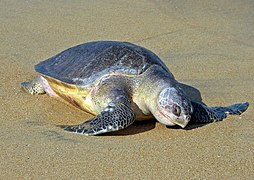Endangered Turtles in the Sundarbans
The Sundarbans' coastal waters and sandy shores along the rivers and canals provide a vital nesting ground for two vulnerable turtle species: Northern River Terrapin (Batagur baska) and the Olive Ridley Turtle.
Northern River Terrapin

This freshwater turtle is distinguished by its broad, smooth shell and striking coloration, with males exhibiting a reddish hue during the breeding season. An adult turtle typically grows to a carapace length of about 60 to 70 centimeters (24 to 28 inches). Adult males can weigh up to 18 kilograms (40 pounds), while females are generally larger and can weigh up to 25 kilograms (55 pounds).
Historically found in the tidal areas of rivers, estuaries, and mangrove swamps, the Northern River Terrapin's population has drastically declined due to habitat loss, poaching, and exploitation for its meat and eggs. Classified as Critically Endangered (CR) on the IUCN Red List, it is one of the world's most endangered turtle species, with ongoing conservation efforts focused on habitat protection, captive breeding, and community-based initiatives to prevent its extinction.
The Turtle Survival Alliance (TSA) and its partners estimate that fewer than 20 adult terrapins survive in the wild in the Sundarbans. The TSA has been working with the West Bengal Forest Department in India to manage a conservation breeding program for the species in the Sundarbans.
Olive Ridley Turtle

The Olive Ridley Sea Turtle (Lepidochelys olivacea), one of the smallest and most abundant sea turtles in the world, has also been spotted in the Sundarbans. Despite their abundance, they are classified as vulnerable due to threats such as habitat loss, poaching for their eggs, and accidental capture in fishing gear.
Named for its olive-colored, heart-shaped shell, this species typically measures about 60 to 70 centimeters (24 to 28 inches) in carapace length and weighs between 35 to 45 kilograms (77 to 99 pounds). Olive Ridley Sea Turtles are found in warm, tropical waters of the Pacific, Indian, and Atlantic Oceans, often near coastal areas and river mouths.
A unique feature of this species is their mass nesting behavior, known as "arribada," where thousands of females come ashore simultaneously to lay their eggs. In the Sundarbans, the uninhabited islands relatively undisturbed by human activity provide a safe haven for Olive Ridley Turtles to nest. Conservation efforts focus on protecting nesting beaches, reducing bycatch, and safeguarding the species' critical habitats.
Turtle Conservation and Research Organizations
Check out these organizations for more information on turtle conservation, education and research projects working to protect these beautiful and ancient reptiles.
Guided boat tours offer the chance to observe these turtles. Join a guided boat tour with GSETS and contribute to the conservation efforts that protect these magnificent reptiles.
Book A Tour Today
Embark on a wildlife adventure